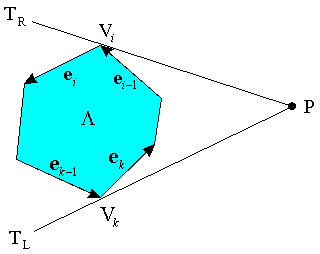前言
切线的构造属于计算几何中的基础问题。存在高效的算法可以计算凸集的切线。对于凹集,其切线与对应凸集的切线相同,所以也能高效计算。因此,我们这里仅仅讨论凸多边形的切线。
寻找切线的算法与寻找极值点的算法(凸多边形的极值点)类似。通过运用相似的二分搜索方法,我们能构造O(logn)复杂度的切线寻找算法。
定义
直线L与多边形S相切定义为:L与S接触,但不穿过S的边界。也就是L仅仅与S的一个点相交或者与一条边重合。
根据上面的定义,S中的所有点要么在L上,要么都在L的同一侧。从外部任意一点,存在两条切线与S相切。
不妨设 ,以逆时针方向给出。
,以逆时针方向给出。 为第i条边,
为第i条边, 为边向量,由Vi指向Vi+1。想象一下,站在Vi点面朝
为边向量,由Vi指向Vi+1。想象一下,站在Vi点面朝 的方向,如果P点在左手边,那么称P点在
的方向,如果P点在左手边,那么称P点在 左侧。
左侧。

如上图所示。记P点为多边形S外部任意一点。对于任意一个顶点Vi,可以用下面的方法很方便地检查直线PVi是否是切线:
考虑Vi前后的两条边 和
和 。如果点P在这两条边的同一侧(同在左侧或者同在右侧),那么Vi-1和Vi+1一定在直线PVi的不同侧,PVi就一定不是切线。反之,若点P在
。如果点P在这两条边的同一侧(同在左侧或者同在右侧),那么Vi-1和Vi+1一定在直线PVi的不同侧,PVi就一定不是切线。反之,若点P在 的左侧,而在
的左侧,而在 的右侧,或者相反,那么点P就是一条切线。如上图,点P在
的右侧,或者相反,那么点P就是一条切线。如上图,点P在 右侧而在
右侧而在 左侧,那么点P是最右切线;同样地,点P在
左侧,那么点P是最右切线;同样地,点P在








 最低0.47元/天 解锁文章
最低0.47元/天 解锁文章

















 1835
1835

 被折叠的 条评论
为什么被折叠?
被折叠的 条评论
为什么被折叠?








